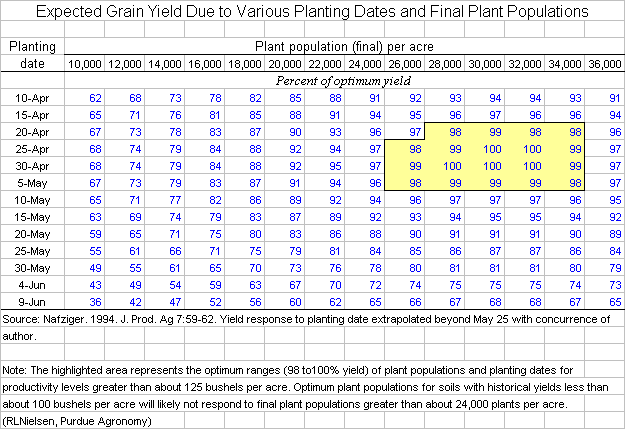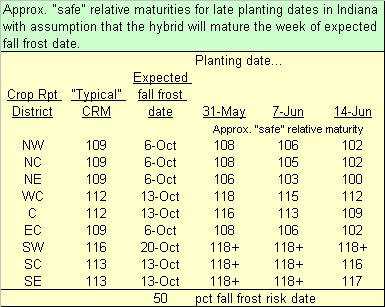Published 23 May 2008
URL: http://www.kingcorn.org/news/articles.08/DelayedPltUpdate-0523.html
More Thoughts on Late Corn Planting
R.L. (Bob) Nielsen
Agronomy Dept., Purdue Univ.
West Lafayette, IN 47907-2054
Email address: rnielsen
at purdue.edu
Completion of the 2008 corn planting season throughout Indiana remains a distant light at the end of a wet tunnel. Planting progress as of 18 May was reported to be 68% complete statewide, but only 37% complete throughout southern Indiana (USDA-NASS, 19 May). Reports are coming in that some of the earlier planted corn is being replanted or may require so in the near future because of unacceptable stand establishment due to damage from soggy soils, soil-borne insect damage, or seedling blight damage. Obviously, the calendar continues to move on or, in the memorable words of John Wayne, "we're burnin' daylight".
Slow drying soils due to cool weather plus additional rainfall that spread throughout much of the state on Friday probably translate to little significant planting progress since the 18 May estimate. While we know from experience that much of the remaining corn acres could be planted in a week's worth of good working days, the upshot is that quite a few acres will either be planted very late or those acres will be switched over to soybeans.
Yield Potential of Late-Planted Corn
Ah, yes.......the $6 per bushel question is how much yield loss should I expect if I continue to plant corn through the early weeks of June? One of the most cited references for that answer is the dataset from the Univ of Illinois that we reproduce in Purdue's ID-179 (Corn and Soybean Guide) and is provided below. Based on that dataset, we can speculate that corn yield potential decreases significantly with late May and early June plantings. As I've indicated before though (Nielsen, 2008a), these estimates are relative to the yield potential of a given year. If the remainder of this growing season turns out to be fantastic for corn, the percent yields listed in the table may yet result in acceptable actual bushel yields. If, however, the remainder of this growing season continues to be a sorry mess for corn, then the percent yield losses listed in the table will translate to even sorrier actual bushel yields this fall.

Hybrid Maturity for Late-Planted Corn
Growers who intend on "sticking to their guns" with corn acres
should be talking with their seed dealers now about possible switches to earlier
maturity hybrids, especially those who farm in northern or eastcentral Indiana.
 The
accompanying table lists relative hybrid maturities that could safely be planted
over the next three weeks based on expected heat unit needs and a "normal"
accumulation of heat units from planting to a killing fall frost date. See
my earlier article (Nielsen, 2008b) for more detail on how these hybrid maturity
recommendations are developed.
The
accompanying table lists relative hybrid maturities that could safely be planted
over the next three weeks based on expected heat unit needs and a "normal"
accumulation of heat units from planting to a killing fall frost date. See
my earlier article (Nielsen, 2008b) for more detail on how these hybrid maturity
recommendations are developed.
The good news, if there is any, is that growers in southern Indiana could continue planting adapted full-season hybrids through the middle of June with little if any risk of the crop not maturing prior to a killing fall frost. Today's reality is that "full-season" hybrids for many southern Indiana growers are earlier maturity than those listed in the accompanying table. Plant breeders have made such improvements in the yield potential of 110 - 115 day hybrids over the past decade that many growers take advantage of their excellent yield potential and drier grain versus later maturity hybrids.
Tip: Growers who elect to switch to earlier maturity hybrids should consider using hybrids with the Bt-corn borer trait, especially in southern Indiana. European and southwestern corn borers are especially attracted to late-planted corn. See John Obermeyer's recent newsletter article (Obermeyer, 2008).
Another tip: Growers who elect to switch to earlier maturity hybrids should pay close attention to choosing hybrids with excellent disease resistance and general late-season plant health or standability characteristics.
Seeding Rates for Late-Planted Corn
The only consideration for seeding rate decisions and late planted corn is that growers may want to reduce their seeding rate just a tad. Optimal final stands for late-planted corn are similar to those for earlier-planted corn (see above planting date/population table), BUT recommended seeding rates for earlier-planted corn are calculated assuming that 5 to 10% of the seed either will not germinate or subsequent seedlings will die due to typical wet, cold, and otherwise crappy early season conditions. One of the few positive aspects of late-planted corn is that stand establishment should be more successful due to warmer soils and more rapid germination/emergence conditions. So, instead of bumping seeding rates by roughly 10% as we suggest for earlier-planted corn, growers could back off to seeding rates that are equal to or 5% above their target final populations.
Seeding Depth for Late-Planted Corn
The key factor for selecting seeding depth for late-planted corn is uniformity of seedbed moisture for germination. One of the risks of later planted corn is that the seed zone can dry out much more quickly than it usually does with earlier-planted corn. Check the seedbed moisture conditions the day you plant and give some credence to the 6 to 10 day rainfall forecast. Aim for a seeding depth that will best ensure uniform soil moisture, but do not plant any shallower than 1.5 inches.
Starter Fertilizer for Late-Planted Corn
Whether or not starter fertilizer will "pay off" with late planting is often not easy to predict. However, given that the benefits of starter fertilizer are most evident when the first 30 to 45 days after planting are wet, cold, and otherwise crappy, one could argue that there may not be much reason to use starter fertilizer for late-planted corn. The high cost of many starter fertilizer sources this year may also influence this decision.
Related References
Jeschke, Mark and Steve Paszkiewicz. 2008. Hybrid Maturity Switches Based on Long-Term Research. Pioneer Hi-Bred Int'l Inc. [On-line]. Available at http://www.pioneer.com/web/site/portal/menuitem.683e661c8aed591aa9fbbff5d10093a0. [URL accessed 5/23/08].
Lee, Chad. 2008. Late Corn Planting Dates and Potential Yields. Univ. of Kentucky. [On-line]. Available at http://www.uky.edu/Ag/GrainCrops/Briefs/Corn_LatePlanting2008.htm. [URL accessed 5/23/08].
Nielsen, R.L. (Bob). 2008a. Corn Planting Date is Important, But.... Corny News Network, Purdue Extension. [On-line]. Available at URL: http://www.kingcorn.org/news/articles.08/PltDate-0412.html. [URL accessed 5/23/08].
Nielsen, R.L. (Bob). 2008b. Late Planting/Replanting & Relative Hybrid Maturity. Corny News Network, Purdue Extension. [On-line]. Available at URL: http://www.kingcorn.org/news/articles.08/DelayedPlt_Hybrids.html. [URL accessed 5/23/08].
Obermeyer, John. 2008. Consider Corn Borer-Bt for Late-Planted Corn in Southern Indiana. Pest & Crop Newsletter (16 May), Purdue Extension. [On-line]. Available at http://extension.entm.purdue.edu/pestcrop/2008/issue7/index.html. [URL accessed 5/23/08].
Thomison, Peter. 2008. Should Seeding Rates be Changed for Delayed Corn Plantings? C.O.R.N. Newsletter (20 May), Ohio State Extension. [On-line]. Available at http://corn.osu.edu/index.php?setissueID=229. [URL accessed 5/23/08].
USDA-NASS. 2008. Indiana Crop & Weather Report (19 May 2008). Indiana office of USDA's National Ag. Statistics Service. [On-line]. Available at http://www.nass.usda.gov/Statistics_by_State/Indiana/Publications/Crop_Progress_&_Condition/2008/wc051908.pdf [URL accessed 5/23/08].

